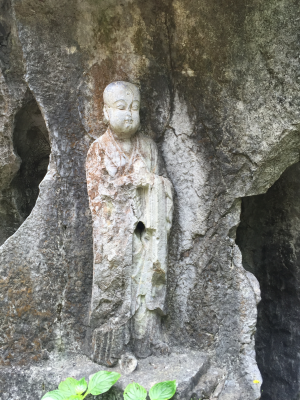This is Part I of a three-part series. View Part II here.
In Sanskrit, the term Nirvana literally means transcendence. A Buddhist concept, it is also closely related to the Hindu idea of Moksa, meaning liberation or salvation. But just as the Silk Road is not about silk – many other goods were traded through it and China was not always the provider of these goods – the Nirvana Route, the concept I discuss here, is not just about Nirvana. The Nirvana Route captures the story of the spread of Buddhism from India to China (and then to Korea and Japan), and that of Hinduism and Buddhism to Southeast Asia. It also harks back to the encounters in literature, arts, trade and politics, for a millennium and a half, from the first century to the 16th century AD – encounters that laid the cultural foundations of modern Asia.
Today, as Asia struggles to find unity and stability, the term Nirvana Route may have considerable resonance. The story of Buddhist (and relatedly Hindu) diffusion it captures is really the only substantial historical-cultural tradition shared across Asia, otherwise a continent of much diversity.
Chinese Naming of India
Historians tell us that India is named after a river. The Rig Veda mentions the river as Sindhu. That became Hindu for the Persians, when their King Darius I conquered the lower basin of the river in the late sixth century BC to create a new province of Hindus. The Greeks, arch-rivals of Persians, knew of the river as the easternmost part of the Persian empire. Their historian Herodotus called it Indus or Indos. After destroying the Persian empire, Alexander the Great reached the river (but was stopped by a local ruler, Puru), an episode that gave “India” ever great prominence. Later, the Muslim conquerors and wannabe conquerors called it Hindustan, which also signified the faith of its majority. Out of all this, the British got their idea of calling their colony India, which was then globally accepted.
But for the Chinese, the name India meant not a river, but a celestial body. The Chinese had different names for India. One was Tien-chu which was derived from the Persian Hindus. However, Xuanzang, the famed seventh century Chinese pilgrim who visited Nalanda and was honored by King Harsha, had a different view. In his travelogue, entitled “Buddhist Records of the Western World,” he wrote: “We find that the names of India (Tien-chu) are various and perplexing. It was anciently called Shin-tu, also Hien-tau, but now, according to the right pronunciation, it is called In-tu…we will call the country In-tu.” Xuanzang then described what the name “In-tu” means. “In Chinese,” he wrote, “the name signifies the moon. The moon has many names, of which this is one.”
But why the moon? How does it relate to India? Xuanzang went on:
For as it is said that all living things ceaselessly revolve on the wheel (of transmigration) through the long night of ignorance, without a guiding star, their case is like (the world), the sun gone down, as then the torch affords its connecting light, though there be the shining of the stars, how different from the bright (cool) moon; just so the bright connected light of holy men and sages, guiding the world as the shining of the moon, have made this country eminent, and so it is called In-tu.
Thus was India reinterpreted by China, with reference to both Nirvana and light, well before anyone had recognized the role Buddhism played in the cultural transformation of Asia. The recognition of Buddha as the “Light of Asia” comes from Sir Edwin Arnold’s book of the same title, first published in London in July 1879. Yet more than 1,200 years earlier, the monk Xuanzang, from the heart of Asia’s greatest empire, had seen Buddha as the bright but gentle beams of the moon, and India as the source of that light.

Big Wild Goose Pagoda, Xian, China. This is where Xuanzang worked to translate the Buddhist manuscripts he brought from India. Photo by Amitav Acharya.
When I first visited Xi’an, the modern name of the ancient Tang capital of Chang’an, in 2010, my first stop was the Big White Goose pagoda. This is where Xuanzang’s worked to translate the hundreds of scriptures he brought back from India. Some of the original manuscripts are still there, enclosed in thick glass cases. The walls of the translation halls have murals with a detailed account of his travels in India, including his meeting with Shailavadra, the abbot of Nalanda, and his meeting with King Harsha, and his debate with the monks of the Hinayana sects of Buddhism. Xuanzang is presented here as having had a magnificent reception in India.
Xuanzang’s travel to India not only gave new life to Chinese Buddhism, but also had an enduring effect on the Chinese literary imagination. One of its main results is the fictional narrative of “Journey to the West,” a Chinese novel published in the 16th century but based on much earlier Song dynasty era legends. The hero of the novel is Sun Wukong, the Monkey King who accompanies the monk Tan Sanzang to China’s western regions. That “West,” the same “West” in Xuanzang’s records, was India. Sun Wukong has an uncanny resemblance to Hanuman of the Indian epic Ramayana. Both have extraordinary abilities, and each provides protection to a virtuous master, Rama in the Indian epic and the Buddhist monk Tan Sanzang (based on Xuanzang) in the Chinese novel.
Founding the Silk Road
Taking a step back in history, the route that Xuanzang took would form part of what became known as the Silk Road. The origins of the Silk Road go back to the second century BC, when the Western Han Emperor Wudi dispatched General Zhang Qian to gather information on tribes living beyond its western frontiers and to secure an alliance with the nomadic Yuezhi tribe against the Turkic Xiongnu enemies of the Han. But the Yuezhi had moved far away and settled on the northwest borders of India after embracing Buddhism from the Indo-Greek Kingdom of Bactria. It was from their tribe that northern India would get the Kushan dynasty in the second century AD, with its most famous ruler being Kanishka. What started as strategic intelligence by General Zhang Qian flourished as a Nirvana Route, as a highway of ideas between India and China that took Buddhism to China and reshaped its civilization.
Soon after the Silk Road’s founding, Buddhism arrived in China, at least officially, since there are also some signs of earlier Buddhist contacts with China, including during the Qin dynasty period. But imperial patronage by the Han dynasty was key to the success and spread of Buddhism in China. In 65 AD, Eastern Han Emperor Mingdi, trying to make sense of a dream he had about a shining image hovering above the palace, dispatched his officials to get more information about a magical figure then being worshipped in the lands to the west of China. These officials returned with two Indian monks and some images of the Buddha, carried on a white horse, which were then placed at a newly constructed temple in Loyang, becoming China’s first Buddhist temple, the White Horse pagoda.
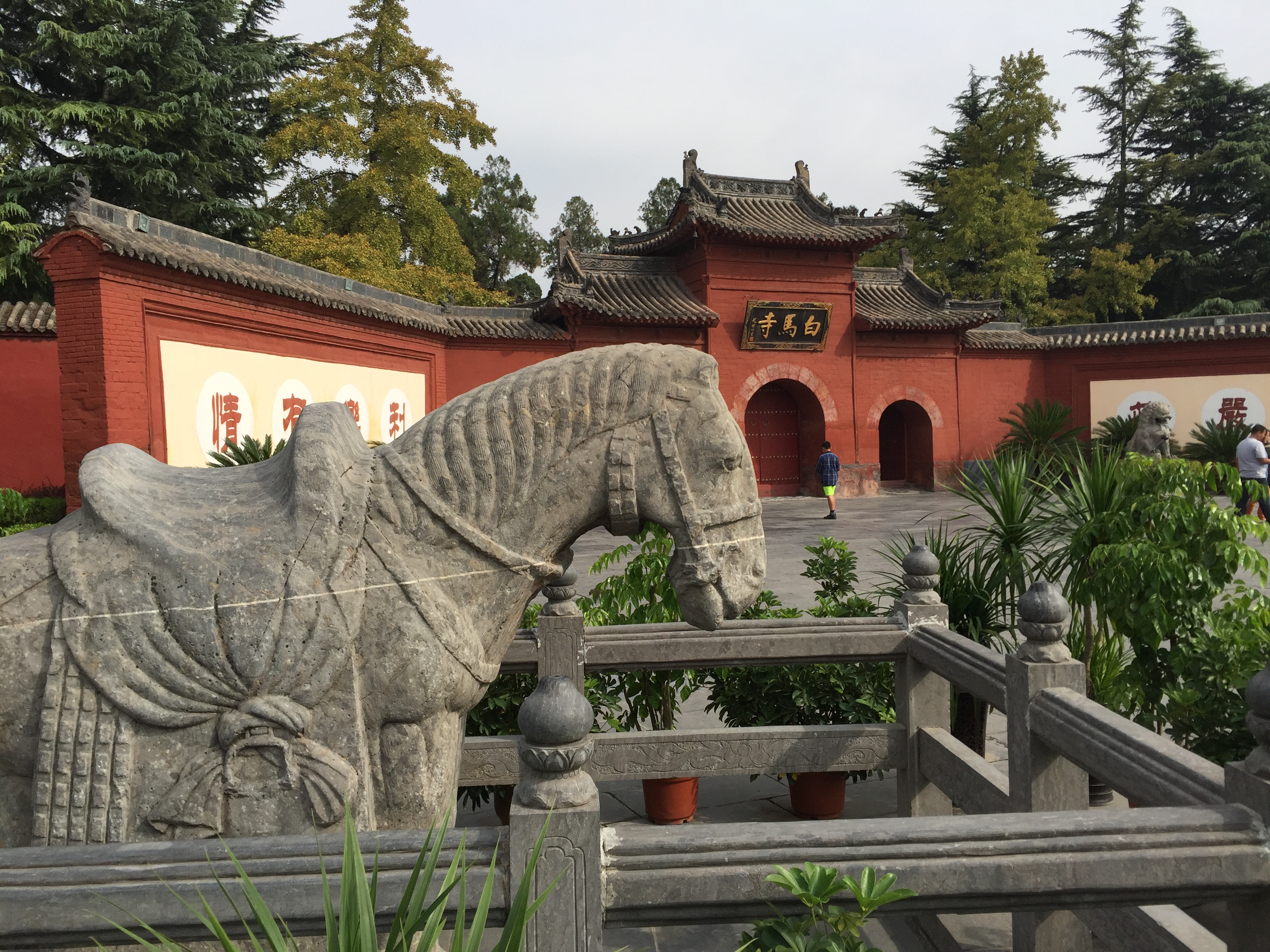
White Horse Temple in Louyang, believed to be China’s very first Buddhist temple Thought rebuilt many times, the current temple is believed to be at the site of the first temple built by Emperor Mingdi in 65 AD. Photo by Amitav Acharya.
The founding of the Silk Road and the arrival of Buddhism altered the Chinese worldview. Until Buddhism came to China, the Chinese understood the “world” in terms of the Zhou Dynasty (founded in 11th century BC) concept of Tianxia (all under Heaven). But this referred to its immediate and limited geographic environment, where China was the “middle kingdom,” surrounded by “barbarian” societies. With Buddhism, the Han Chinese came to realize that there did exist other major civilizations to the west, such as India and Rome.
Buddhism gained mass popularity in China after the collapse of the Han dynasty in early third century AD, as many Chinese facing a period of uncertainty and anxiety turned to Buddhism to seek relief and solace. The expansion of Buddhism in China was a multi-ethnic enterprise. Anyone interested in exploring how Buddhism arrived to China via the Silk Road must visit the Yungang Grottos, near Datong, in China’s modern Shanxi province. The magnificent caves were built in the second half of fifth century AD by the Northern Wei dynasty, founded by the Tuoba clan of the Xianbei tribe (a proto-Mongol ethnic group) which ruled northern China from 398 AD to 534-5 AD. The complex, with 252 grottoes and more than 51,000 Buddha images, are located some 16 km from the modern city of Datong (ancient name Pingcheng) which was the capital of the Northern Wei Dynasty between 398 and 494 AD, when it shifted to Luoyang.
A key message of the Yungang grottos is the sinification of Buddhist imagery. Within a span of less than 50 years, Buddhist images underwent a major transformation from the initial Indian and Central Asian (China’s western regions) design to native Han style.
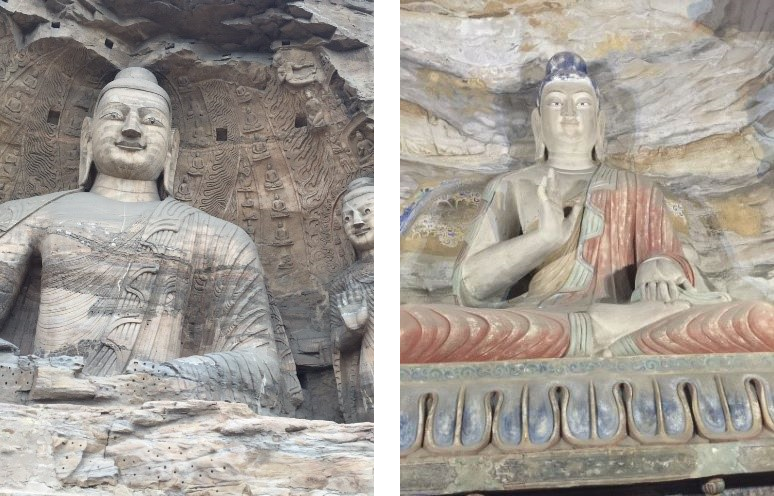
Although Buddhism arrived in China during the Eastern Han, it was the non-Han Northern Wei dynasty which crafted the most impressive Buddha images at Yungang Grottos in Shanxi. These images illustrate the transformation from colossal statues with distinctive central Asian features (left image) to more subtle Chinese forms (right image). Photo by Amitav Acharya.
A key role in the spread of Buddhism from India to China was the two-way traffic of monks and merchants. Xuanzang was by no means the only Chinese pilgrim to visit India and link its civilization with that of China. He had been preceded by Faxian (who came by the desert and returned to China by the sea) and followed by Yijing (who made both the legs of his journey to India by the sea route). Nor was it a one-way traffic of Chinese monks visiting India. A possibly greater number of Indian monks travelled to China to preach, teach, translate, and advise. During the fifth and sixth centuries, a parade of Indian monks with names such as Gunarahhata, Gunavarman, Gunabhadra, Shanghbhadra, and so on, spread out in China founding monasteries and temples and translating Buddhist sutras (some of these Indian monks were fluent enough in Chinese to write books in Chinese). One prominent monk was Paramartha (Zhendi in Chinese), who arrived in China in 546 AD and spent 12 years in the area now called Guangzhou, playing a key role in the introduction of Mahayana Buddhism to China.
The Buddhist Imperium of the Tang Dynasty
But Buddhism’s golden age in China was during the Tang, which in 618 AD took over from the short-lived Sui dynasty that had reunified China in 581 AD. It was during the Tang that Buddhism had a major impact on China’s imperial politics. Nothing attests to the politicization of Indian Buddhism in China more strikingly than the manner in which China got its first and only female emperor, Wu Zetian. Wu started as the concubine of Emperor Taizong, the very same who had refused Xuanzang permission to travel to the west (although the Chinese were delighted to have the wealth of information about foreign lands contained in his Buddhist records for their intelligence value).
By 690 AD, in the face of stiff opposition from the Confucian officials that objected to a woman of low birth assuming political power, Wu had usurped the Tang throne. Instrumental to her effort was help from the Buddhist clergy. As Tansen Sen points out, at first, Wu was presented as a female Maitreya descending from the Tushita heaven into the magical city (Luoyang). But when this seemed too far-fetched, Wu got Bodhiruchi, an Indian monk she had earlier invited to China, along with scores of other Indians including Brahman alchemists and astrologers popular in Tang China, to write an entirely new Buddhist text, the Ratnmegha Sutra, that anointed her as the female Bodhisattva Vimalaprabha. In any case, Wu was cast as a chakravartin destined to rule all of India.
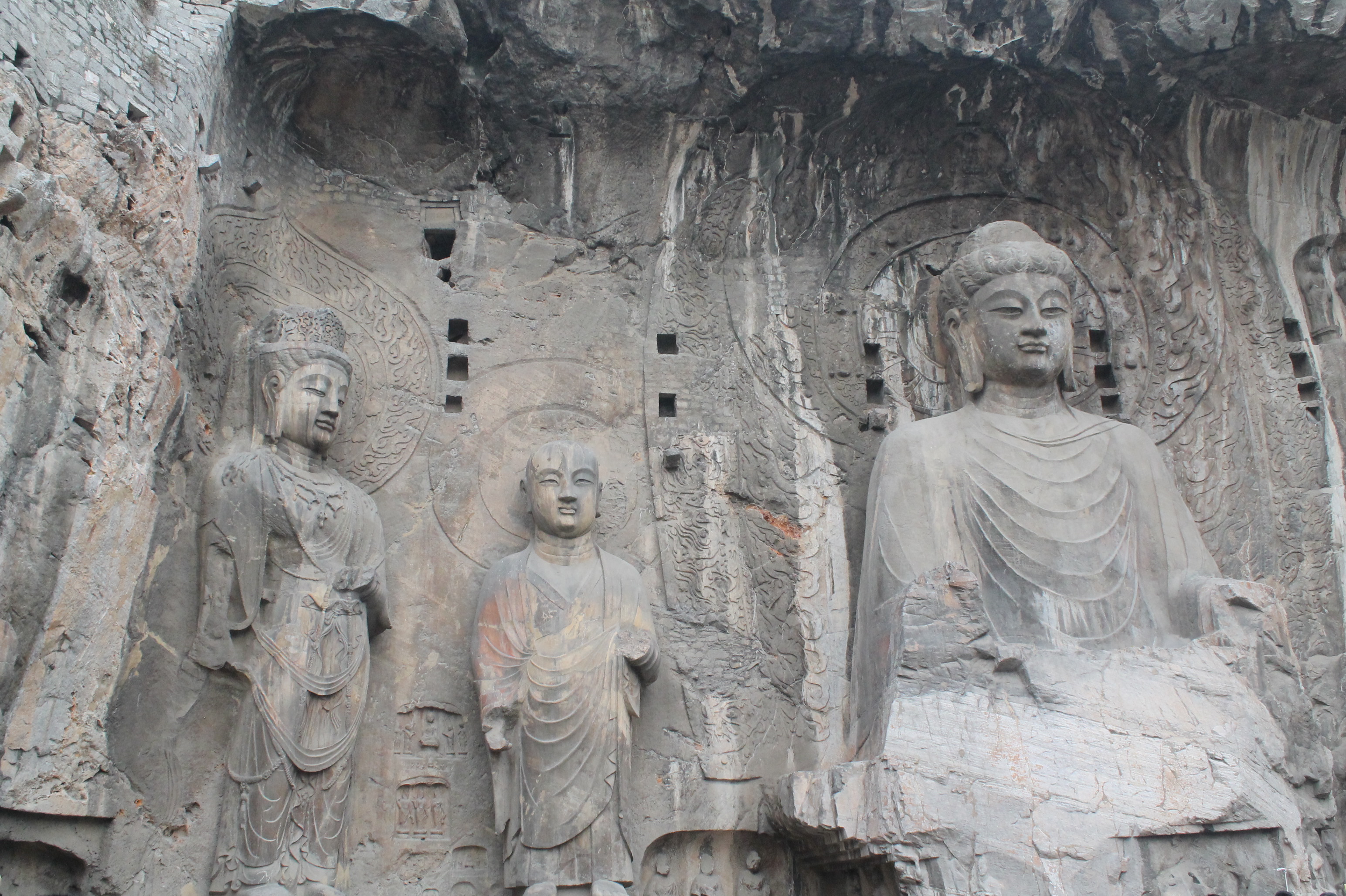
A giant (17.14 meters) Buddha Vairochana image with disciples Ananda and Kasyapa in Fengxiansi Cave, Longmen grottoes, Henan province. Completed in 675 AD, this image’s feminine features have spurred speculation of it being a “portrait” of Wu Zetian, who donated 20,000 strings of cash for its construction. Photo by Amitav Acharya.
The Origins of Zen (Chan)
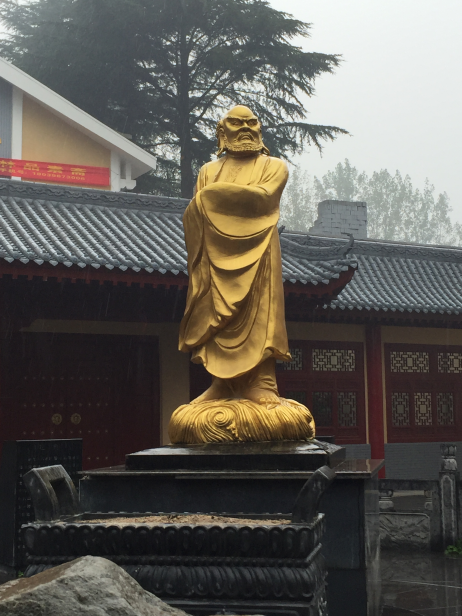
A contemporary statue of Boddhidharma (Damo) at Shaolin temple in China’s Henan province. Photo by Amitav Acharya.
A century before Xuanzang’s travel to India, a South Indian prince named Bodhidharma had arrived in China. Bodhidharma, or Damo to the Chinese, is little known in India. Some Chinese accounts believe he was not Indian at all, but came from Central Asia. But if he was indeed a prince from South India, as other accounts hold, he would be the single most important Indian to have ever set foot in China. Damo’s images can be found throughout China, but the site most associated with him is the Shaolin temple, also known as the place where kung fu was invented. Damo’s own role in creating this martial art is not clear, but his steadfast upholding of Buddhist precepts and his skill in meditation are legendary.
After arriving in China, Damo met with the Southern Dynasty Emperor Wu in Jiankang (Nanjing). The emperor was a devout Buddhist who had provided considerable support to the Buddhist sangha and now he sought validation of his pious acts from Damo. Damo refused, saying that it was inappropriate for an emperor to seek praise for the good deeds he had done for the subjects. Having angered the emperor and therefore spurned by him, Damo crossed the Yangtze River (allegedly on a leaf), to reach Shaolin, which had been founded earlier by another Indian monk. At a mountain top cave there, he sat for 12 years in uninterrupted meditation, facing the wall. He is regarded as the first Chinese patriarch of Chan (Zen) Buddhism. Around the 12th century, Damo’s Chan Buddhism migrated to Japan as Zen, and further rejuvenating Japanese Buddhist culture.
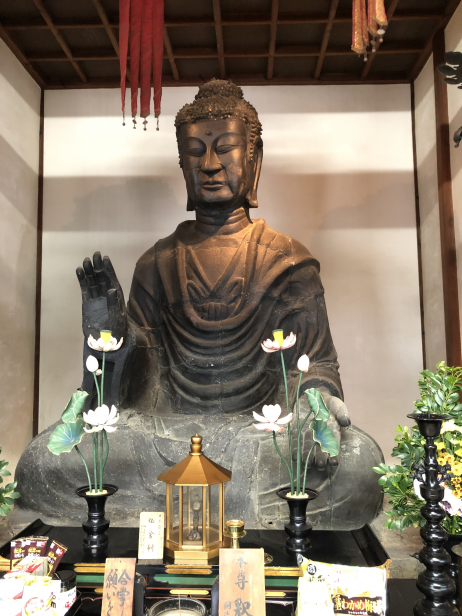
The Great Buddha in Asuka Temple, near Nara, crafted in 609 AD, is the earliest extant Japanese Buddhist image. Made by a Korean sculptor, its features illustrate the key role of Korea in the earliest transmission of Buddhism to Japan. Photo by Amitav Acharya.
Buddhism found its way from China to Korea in the fourth century AD and then from Korea to Japan in the sixth century AD. Korea’s role as an intermediary as well as creator of Buddhist art is important here. Buddhism arrived in Japan in 552 AD, with the gift of a Buddhist statue from the king of the Korean state of Paekche to Japanese ruler Kimmei Tenno, it was opposed by some sections of the feudal elite, who thought it would undercut the local Shinto belief. This set off a struggle between the two most powerful families of Japan: the pro-Buddhist Soga, who thought Japan should not be left behind in embracing a belief that had been adopted in many other countries to the west (Korea and China); and the Mononobe, who feared worshipping a foreign deity might anger the Kami deities. But such conflict would be resolved by marrying the Buddhist beliefs onto pre-existing and long-established Shinto customs.
Arriving in Japan, Buddhism intermingled with the traditional Japanese animistic belief, Shinto, and Japanese society came to see the Buddhist pantheon, including Bodhisattvas, as Shinto deities, or Kami. This combination of Buddhist Nirvana and Shinto magical power gave Japanese emperors much of their legitimacy. Later, Japanese esoteric Buddhism (Mikkyo) would absorb a number of Hindu deities, such as the Twelve Deva Kings (Juniten), that includes such prominent Hindu gods as Brahma, Indra, Agni, Varuna, and Yama (other Hindu deities in Japan Buddhism outside of the 12 include Lakshmi, Uma, Ganesha, and Saraswati), in one of the most interesting fusions of the two religions outside of India. Some Hindu deities were placed as guardians in Japanese Buddhist temples.
(Stay tuned for Part II: “Journey to the East: The Hindu-Buddhist Making of Southeast Asia.”)













